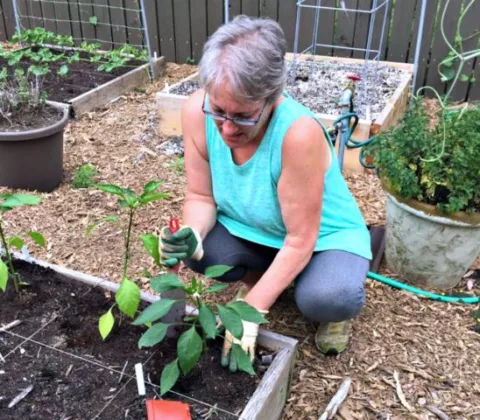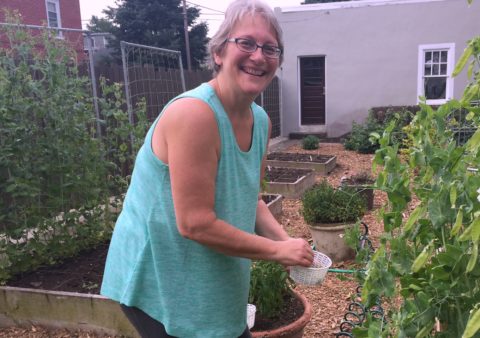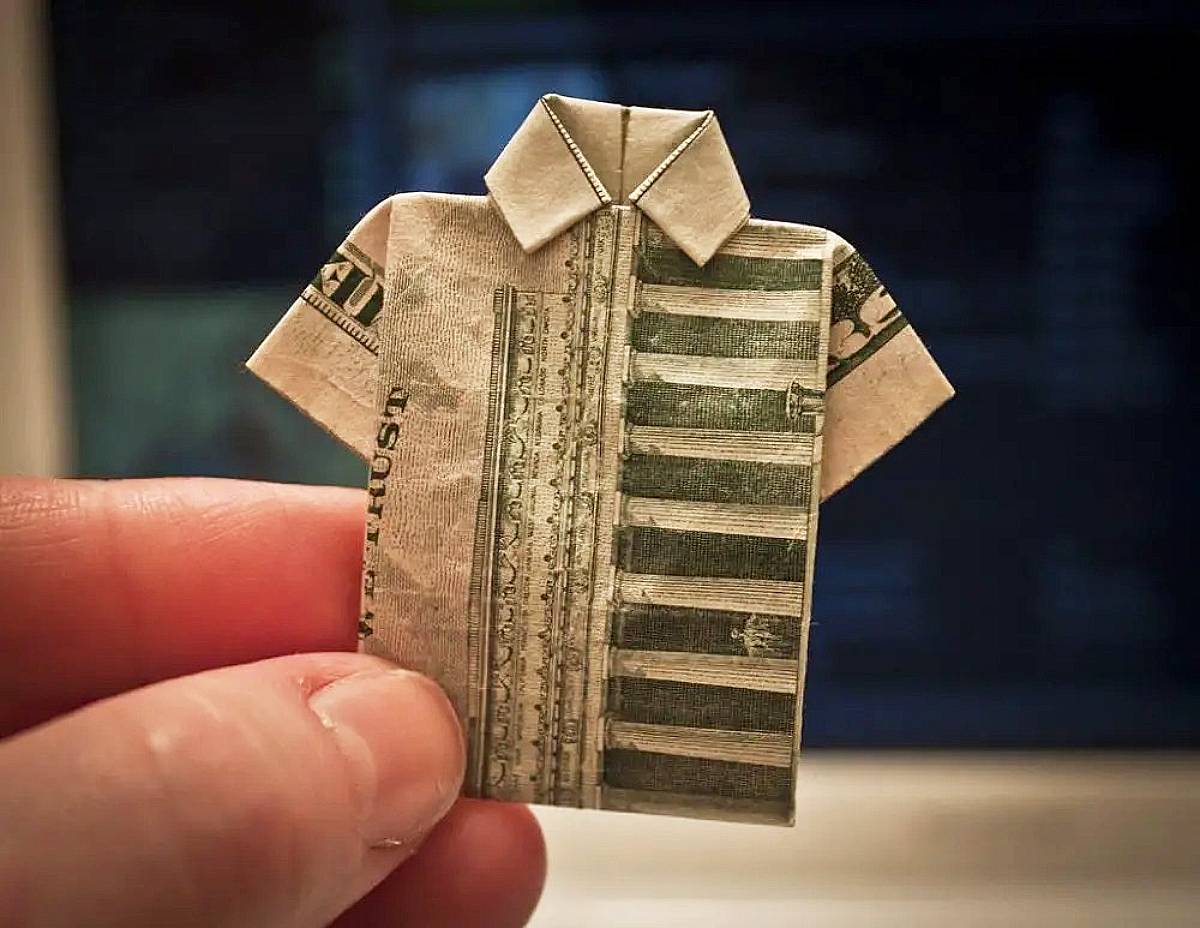Want to save money growing vegetables in your own backyard? Gardening at home also pays you back in freshness and convenience.
I live in a small urban city and so does my friend, Myra. She has a beautiful garden that is producing tons of fruit and vegetables already this season.
She chuckled when I asked her how much money she saves. “A lot of money saved on therapy,” was her answer. Gardening is very cathartic for Myra — and for many others.
Seriously though, you can save money growing vegetables yourself.
You’ll also contribute to overall energy savings in reduced fuel consumption and transportation costs of market items. And a home garden lets you control what pesticides, if any, you will use.
I’m going to explain how to set up your backyard vegetable garden and what to plant, plus I’ll sharing some some money saving tips with you while I’m at it!
You might think that you can’t save much money building a vegetable garden — because of the expense of getting everything planted. But that isn’t necessarily the case.
Yes, it’s possible that the expense of getting started the first year may yield only a slight reduction in grocery bills, but if you follow these tips over the long-term, you’ll really reap what you sow! (See what I did there?)
How To Save Money Growing Vegetables
Maybe you’re a numbers person and you want to see an example of how much money can be saved when you grow your own vegetables. Have a look at this gardener’s savings.
Her startup costs (including raising backyard chickens) were just $278, yet she calculates her harvest of eggs, tomatoes, kale, onions and potatoes would have cost her approximately $1,770.89 at the grocery store — equaling a savings of $1,492.89. Source
One thing’s for sure: planning is essential when gardening to save money!
Here’s how to save money growing vegetables:
- Plant what you eat. This sounds like common sense, but more than one backyard gardener has been tempted to plant a variety of impressive-sounding foods they never actually use.
- Plan well to maximize your yield. Maximize the space you have available by planting high-yield crops — like tomatoes, onions, and leaf lettuce.
- Save your own seeds. It’s not necessary to spend $10 or $15 (or even $30) each year on seeds. Saving vegetable seeds from your own garden and then planting them the following year can cut your annual seed bill in half.
- Participate in a seed swap. A great idea if you’ve saved seeds from your garden produce, have more than you need, and you’re willing to part with some of them to gain seeds of another variety.
- Sell or barter with your extra. Produce stands want to sell your stuff, they just don’t know how to find you — because you’re not a company and you don’t advertise your garden obviously.
- Make your own compost. Composting is a simple way to add nutrient-rich humus — which fuels plant growth and restores vitality to depleted soil. It’s also free, easy to make, and good for the environment.
- Plant your scraps. Organically bought “parent” vegetable scraps re-grow better than store-bought ones. Plus, organic food just tastes better and is better for you.
- Grow perennials. After the first year, you can begin planting the mulched area with perennial vegetables, fruiting shrubs, and vines. (Remember, you’re looking for long-term savings too.)
Some tips to optimize your yield:
- Try trellising – Any time that you can grow a vegetable on a trellis, it increases your yield per square foot. Plants that trellis well include cucumber, cantaloupe, tomato, and sweet peas.
- Plant wide rows – Growing small, leafy plants — such as leaf lettuce, spinach, and arugula — 3 or 4 rows abreast (without walking aisles in between) gives you more food per square foot.
- Use raised beds – Raised beds organize the garden, letting you concentrate on the most productive items.
- Start with transplants – Plants are several weeks old when you put them into the ground — which gives you a head start to harvest time for most plants, compared to starting from seed.
Don’t underestimate your vertical space. Use whatever you have to allow climbing plants to grow up and save precious garden space.
Here are some great ideas to create a backyard vegetable garden with very little space.
How To Save Money Preserving Vegetables
Plant now. Eat later.
By selecting vegetables that have a long storage life — or that can easily be canned or frozen — you’ll be stretching your grocery dollar!
For example, vegetables like beans, tomatoes, cucumbers, beets, and sweet corn can be preserved by canning or freezing.
Preserving vegetables is a great way to enjoy the “extra” produce later in the year.
To get the most bang for your gardening buck, keep your plants simple and stick to produce that really performs. You can add more to your plate next year, after you get the hang of things.
Here is some super helpful information on canning vegetables.
Which Vegetables To Plant
You have a lot of choices when it comes to deciding which vegetables to plant in your garden. But if you want the best return (food-wise and money-wise), then keep the following 2 lists in mind.
Do plant these in your backyard vegetable garden:
- Lettuce and spinach: Lettuce replenishes quickly. Stick to leafy varieties of lettuce — because the whole-head kind takes longer to mature.
- Tomatoes: Tomatoes can save you a bundle. Plus, with a little canning now, you can enjoy homemade tomato sauce, tomato juice, and salsa all winter long.
- Squash, zucchini, and cucumbers: Plant these super performers sparingly and give them plenty of room to spread their wide leaves.
- Bell peppers: For the cost of 1 or 2 bell peppers at the store, your own pepper plant will produce an entire bag of this versatile veggie!
- Green beans (or pole beans): As long as the soil is warm and the sun is shining, these guys are the gift that keeps on giving.
- Herbs: If you’ve ever bought fresh herbs at the grocery store, you know why this one’s on the list!
Don’t plant these in your backyard vegetable garden:
- Potatoes: At less than $1 per pound on average, it’s better to just buy potatoes from your local farmer or grocery store.
- Carrots: One carrot seed equals one carrot (and that’s if you have the right kind of soil).
- Watermelons: They require rich soil, lots of water, tons of room, and about 80 days before they’re ready to pick and eat.
- Asparagus: A slow-starting vegetable that needs 2 to 3 years to mature.
- Sweet corn: Leave sweet corn to the pros. Corn is a one-and-done crop, so save yourself the hassle and support local growers who can plant large enough quantities to make a profit.
No matter what you grow this season, make sure to sow only what you (or your neighbors) will eat, and aim for simple plants that really produce.
I bet you’ll be surprised to find out your green thumb works after all, and you can definitely save some green (bills) when you grow your own vegetables!
I’m a health nut, a frugal mom, a dog lover, a DIYer, and a gadget girl. Personally, as a post-divorce, working single mom on a budget I have a lot of experiences that I enjoy sharing so others can learn from the things I wish I knew earlier! Professionally, I’ve worked full-time in a variety of marketing, sales, and editing jobs. You can always find me at the corner of Good News & Fun Times as Managing Editor at The Fun Times Guide (32 fun & helpful websites).






